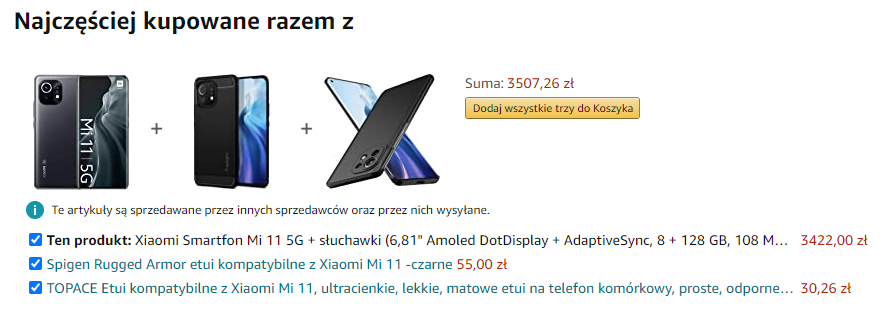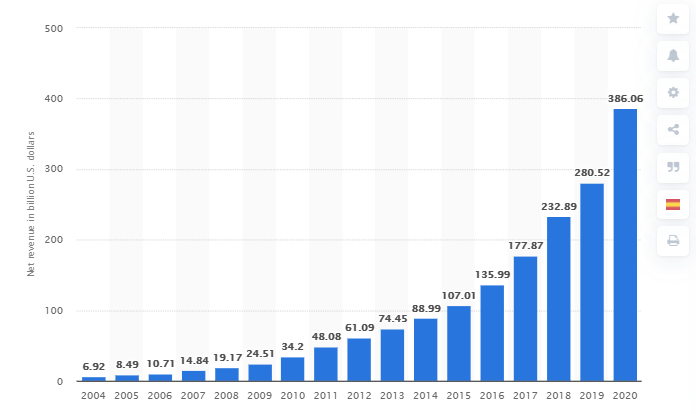Amazon's Product Recommendation System In 2021: How Does The Algorithm Of The eCommerce Giant Work?

Amazon is well-known for its extremely accurate selection of recommendations in the online store. It uses technologies such as artificial intelligence algorithms and machine learning to improve customer experience and increase sales.
Amazon's recommendation system is capable of intelligently analyzing and predicting customers' shopping preferences in order to offer them a list of recommended products.
Although other stores have also introduced similar functionalities to their websites in recent years, Amazon's recommendation engine is considered to be one of the best on the market.
In today's article, we will tackle the following topics related to the Amazon algorithm:
- What is the Amazon algorithm?
- How does Amazon's recommendation system work?
- How does Amazon recommend products?
- How do Amazon's recommendations affect sales?
- Can you use Amazon's strategies in your online store?

Amazon's history in a nutshell
It was 1994 when Jeff Bezos quit his lucrative job with a hedge fund and started Amazon.
In the first month of its release, the company already sold books to customers in all 50 states and 45 different countries around the world and generated $ 20,000 in net profit per week.
In the 25 years since it was founded, Amazon is the largest eCommerce platform on the market, generating up to $ 280.5 billion in net profit in 2019. In 2021, the Amazon online store entered the Polish market.
In addition to the revolutionary business model and well-thought-out management, a very large part of Amazon's global success boils down to the constant improvement of the platform and the introduction of innovative solutions.
What is the Amazon algorithm?
Along with the developing AI technology, Amazon began working on an algorithm that would be able to analyze items posted by users and determine the shopping preferences of individual customers.
Amazon's algorithm is a recommendation engine consisting of several important parts responsible for the analysis of various data. This is possible thanks to technology based on artificial intelligence and machine learning.

How does Amazon use artificial intelligence in sales?
Existing customers expect the online store to provide them with personalized content and to diversify their shopping experience.
According to the latest research on personalization, up to 91% of online store customers admit that they are more likely to use a brand's offer that personalizes their experience and 98% of eCommerce website owners say that personalization improves their relationships with customers.
Whether it is improving your click - through rate, increasing the number of views or reducing your bounce rate - personalization is the key to achieving all of these goals.

By providing recommendations that maximize potential value for individual customers, Amazon is able to keep consumers engaged and offer products of interest to them that they might not even think about.
Amazon and personalization of the shopping path
The company created the Amazon Personalize tool to personalize purchases.
It is an artificial intelligence and machine learning service that specializes in developing recommender system solutions. It automatically analyzes data, selects functions and algorithms, optimizes the model based on the data, and implements and maintains the model to generate real-time recommendations.
This system goes beyond standard eCommerce recommendations and can be used by developers to build complex, intelligent systems recommending other websites.
In addition to the recommendations themselves, Amazon uses several other artificial intelligence algorithms responsible for supporting various aspects of the platform's operation.
The company also uses the proprietary A9 algorithm, which is responsible for intelligent product search on the website.

This system is also the basis for determining which sellers will be displayed to buyers on the home page.
The Amazon A9 algorithm is based on 3 basic principles of operation:
- It takes into account keywords, content, seller data, opinions and reviews and return rates to identify the best products.
- The A9 algorithm classifies products based on the history of sales results, accuracy of text matching, price and stock availability at individual sellers.
- There are also indirect factors that influence the position of individual products in the classification of the algorithm. The most important of them include, among others, delivery and payment options, product descriptions and photos, premium content, advertising and promotions.
Amazon recently updated the A9 algorithm, which is now referred to as the A10 algorithm. .
The update changed many aspects of its operation, making it more focused on buyer’s behavior than the product characteristics themselves.
How does Amazon's recommendation engine work ?
In order to provide customers with accurate product recommendations, Amazon's algorithm must analyze huge amounts of data.
In this way, it better understands the behavior of all users and the interests of each viewer.

- general data about products and users;
- data on relations and dependencies between them.
Getting to know the existing relationships in the online store will provide the recommendation engine with an insight into the real mechanisms governing customers' purchasing decisions.
Amazon's recommendation algorithm analyzes 3 main types of dependencies and relationships for its operation:
-
User-product
This type of relationship occurs when some users with certain characteristics prefer products of a given type and buy them more often.
A good example would be gamers buying expensive computer components or fans of various series and movies buying related gadgets and t-shirts. -
Product-product
Product-product relationships occur when the products offered in the store are similar in terms of both appearance and specification.
Some examples include books, movies, series or music of the same genre, or dishes from the same cuisine. -
User-user
It occurs when individual customers with certain characteristics have similar tastes or preferences for certain products.
Examples of such relationships include teenagers massively buying merchandise from their favorite YouTuber or cooking fans who prefer a specific line of kitchen products.

In addition to collecting information about relationships and connections Amazon's recommendation algorithm also uses different types of product and user data:
-
User behavior data
This type of data is useful information about the preferences of individual customers, their interaction with the products in question. Amazon uses cookies to collect data about your browsing history, likes, or session length. - User Demographics data
User demographics data is linked to personal information about individual customers, such as age, education, income and location. In order to collect such data, the user's consent is required. - Product Attribute Data
Product Attribute data is information related to the product itself, such as the specification of the computer, blouse size information, collection description.
A method of filtering data by Amazon's recommendation algorithm
Many of these systems can be classified as content-based filtering or collaborative filtering.
Content-based filtering on Amazonie
Content-based filtering is one of the simplest systems and is constantly used by modern recommendation systems.
The main idea behind content-based filtering is that if a customer likes a certain product, chances are they will like another product with a similar specification.
Collaborative filtering
Unlike content-based filtering, group filtering uses the experience of other users to generate recommendations.
Interestingly, Amazon pioneered this approach and published the article Recommendations: Item-to-Item Collaborative Filtering in 2003, which later won an award from the Institute of Electrical and Electronics Engineers (IEEE). The undoubted advantage of this method is that it allows the recommendation engine to generate proposals for relatively complex products, such as movies or music, without the need to have specialist knowledge about them.
Compared to content-based filtering, team filtering produces better results in several key areas:
- diversity - group filtering generates a more diverse list of recommended products, offering customers a wider choice,
- randomness - recommendations generated using the collaborative filtering method are much more likely to positively surprise the client and show them a product of interest, which they might not otherwise discover,
- randomness - the collaborative filtering method is able to more effectively present to customers novelties in the store's offer that users would most likely be interested in.

It is worth noting, however, that both collaborative and content-based methods offer the best and most effective results if they work together in one comprehensive recommendation engine.
This is how the Amazon algorithm works - by combining the best elements of both strategies, it offers its clients the highest quality recommendations.
Nevertheless, in recent years, Amazon has been constantly working on new, innovative solutions that could further improve its recommendation algorithm.
Bandit and casual interference - Amazon's hybrid algorithms
Bandit-based algorithm
One of the areas of research on new recommendation algorithms is the so-called Bandit-based algorithms.
The "bandits" algorithm is based on machine learning by amplification (RL) and tries to develop sales opportunities for new products using those already profitable.
Bandit-based algorithms can also be used to make real-time choices between several recommender models based on how users respond to different product propositions.

Casual interference algorithm
Another innovative approach to recommend algorithms that Amazon has worked on is the casual interference algorithm.
It mainly focuses on identifying the factors that prompted individual customers to pay attention to specific products.
By developing an algorithm that combines casual interference with existing recommendation algorithms, Amazon researchers were able to generate improved recommendations by taking into account various confounders.
It is also worth mentioning here that hybrid systems are becoming increasingly popular. Some of these newer approaches are not mutually exclusive and can be combined with each other.
All the strategies listed here are currently being developed and refined by the Amazon team in order to deliver the best product recommendations to customers.
Amazon sales results thanks to recommendations
The implementation of such a complex and advanced recommendation algorithm required an enormous amount of both work and funds from Amazon. However, as we can see from the statistics, this investment brings huge benefits.
Given Amazon 's incredible success in the online marketplace, the recommendation system ... simply works.
The company saw a 37% increase in sales from 2019 to 2020 , from $ 280 billion to $ 386 billion. Undoubtedly, much of this success is due to the way Amazon has integrated recommendations into almost every step of the purchasing process.

What's more, according to the McKinsey study, up to 35% of Amazon's sales are generated thanks to the proprietary product recommendation algorithm.
Currently, the recommendation engine has become a very important part of Amazon's development strategy.
Jeff Wilke, director of the Consumer Division, admits:
At Amazon.com, we use recommendation algorithms to personalize the online store for each customer. The store changes radically based on customer interests, showing programming books to an engineer and baby toys to a new mom.
This can be learned from Amazon - good eCommerce practices
Even though Amazon is an absolute giant in the eCommerce market and has a large R&D budget, smaller online stores can also benefit from the same recommendation strategy in their operations.
There are now quite a few tools on the market for online stores that offer you to enter personalized recommendations in each online store with just a few clicks.
Every online store, regardless of its size, after installing the recommendation engine can enjoy the benefits of using artificial intelligence technology in practice just like Amazon.
The most important benefits of personalized recommendations that we see on Amazon include:
- Increased Sales Revenue - online stores that implement product recommendation algorithms are more effective at generating increased sales revenue.
- Increase Site Traffic – thanks to the recommendation engine, you can significantly increase traffic on your website through better customer experience.
- Increased user satisfaction - buyers want to find what they are looking for quickly and within just a few clicks. Online stores are more effectively able to gain the trust of customers by meeting their needs and expectations. This in turn translates into increased customer retention rates.
- Increased customer loyalty - satisfied customers become loyal customers. And loyal customers will recommend the brand to their friends much more often, providing the company with free advertising.
- Increased engagement of buyers - if the users do not find what they have been looking for on the store website or get lost in the site tabs, the level of their interest will quickly drop and they will look for interesting products on the competitive sites. Presenting the customers recommendations based on their personal preferences can certainly speed up and streamline the journey through the store's tabs and increase the likelihood of making a purchase.
Summary
Amazon's recommendation algorithm is probably the most complex and effective of the eCommerce market. The company has been steadily developing its recommendation system for almost 20 years and is now responsible for a large proportion of sales.
Amazon 's personalized recommendation engine improves customer experience and presents products in real time based on their browsing history, thanks to the use of artificial intelligence and machine learning.